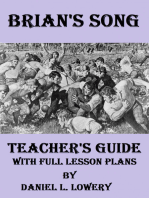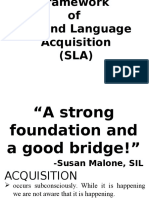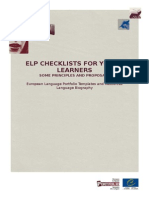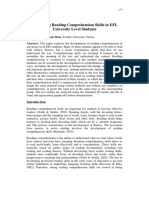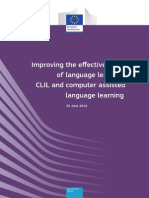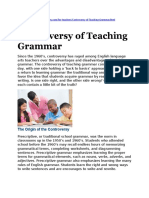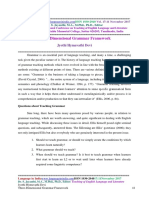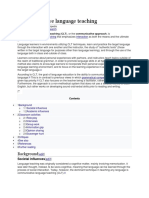Interactive Activities
Uploaded by
Karolina BöhmováInteractive Activities
Uploaded by
Karolina Böhmová4.
SPEAKING ACTIVITIES
Speaking is a complex skill which on the basis of The Common European Framework of Reference for Languages (hereinafter referred to as CEFR) comprises of five qualitative aspects of spoken language use. The first aspect is the range which refers to the vocabulary according to the language level. Further on, accuracy and fluency plays also a significant part. These two aspects are introduced bellow. The competence of communicating is understood as the fourth aspect termed an interaction. And the last but not least, coherence, involves creating a coherent and cohesive discourse, and appropriate use of a wide range of connectors and other cohesive devices (CEFR 2011, 28-29 [online])1 Consequently, its practice is indisputable. Oral interaction activities have various characteristic features and many scholars, such as Littlewood, Ur, or Harmer, who work in the field of language teaching, have proposed their views and applications that might be used in nowadays language lessons. Due to the limited extent of this thesis only the William Littlewoods division of oral interaction activities is taken into consideration for the purpose of this thesis.
4.1. Categorization of oral interaction activities according to William Littlewood
In communicative language learning, students should be provided with a great deal of opportunities to use the language through communicative activities, which should be accomplished in a communicative way. Littlewood (1981) defines four major kinds of activities, which are diagrammatically represented as follows:
(Littlewood 1981, 86)
See Appendix 4 for detailed information according to The Common European Framework of Reference for Languages.
1
Even though there are various classifications of activities which are typically found in communicative language classrooms, Littlewood presents the most important methodological distinction between pre-communicative and communicative learning activities. The former are preparatory activities, intended to prime learners for the second type of task, in which they are required to communicate. (Bygate 1987, 61) The aim of pre-communicative activities is to prepare learners to be able to use appropriate language with no anxiety about communicating effectively. Pre-communicative activities are activities which deal with controlled practice of formal aspects of conversation, and include drills, dialogues, and other exercises where little learner input is required. (Richards 1990, 82) In other words, pre-communicative activities are providing learners with the essential linguistic forms and the requisite bonds between forms and meanings. (Littlewood 1981, 16) Those activities are supposed to prepare learners for later communicative activity and their focus should be more on language forms to be learnt than on meanings to be communicated. (Littlewood 1981, 16) The category of precommunicative activities is also sub-divided. The first variant is composed of structural exercises, which are focusing mostly on the grammatical system of language. The aim of the structural activities is to strengthen the use of the language fluently rather than accurately. The second type is called quasi-communicative and comprises of conversational interchanges, which might be in the form of drills or dialogues. Those activities should help with the use of language to transmit some real information of facts, social context and to discern how to use interrogatives. (Bygate 1987, 62) Some examples of the quasi-communicative activities are mentioned below: 1. A: Shall we go to the concert? B: Well, I would rather stay at home. A: What would you like to do then? B. I would like to watch a movie. 2. C: Excuse me, where is the hospital near here? D: It is near to the post office. C: Excuse me, where is the theatre? D: It is opposite the bank.
According to Bygate (1987), communicative activities insist on learners to use their precommunicative knowledge and integrate it into the full activity of communicating meanings. (p.61) Littlewood sub-divides communicative activities into two alternatives; functional communication activities and social interaction activities. The purpose of the first type, functional communication activities, is that learners should use the language they know in order to get meanings across as effectively as possible. (Littlewood 1981, 20) Littlewood divides the functional communication activities into four types. Sharing information with restricted cooperation is the first type of functional activity which demonstrates the most understandable patterns of interaction. It comprises of activities such as identifying pictures, detecting differences, discovering sequences, locations, or missing information, etc. The second type, sharing information with unrestricted cooperation, reduces the conventions that restrict the cooperation among learners. Sharing and processing information is the third variant that consists of activities such as reconstructing story-sequences or pooling information to solve a problem. Processing information is the last type of functional communication activity and it dispenses completely with the need to share information. (Littlewood 1981, 22-38) The second type of communicative activities, social interaction activities, adds a further dimension to the functional activities and involves role-plays, simulation and social context. Those activities are in close proximity to the communication situations outside the classroom, where language is not only a functional instrument, but also a form of social behaviour. (Littlewood 1981, 43)
You might also like
- Comodibn Sherman Using Authentic Video in The Language Classroom100% (1)Comodibn Sherman Using Authentic Video in The Language Classroom11 pages
- Investigating Tasks in Formal Language LearningFrom EverandInvestigating Tasks in Formal Language LearningMaría del Pilar García MayoNo ratings yet
- Applied Linguistics To Foreign Language Teaching and LearningNo ratings yetApplied Linguistics To Foreign Language Teaching and Learning61 pages
- English For Occupational Purposes: Almut KoesterNo ratings yetEnglish For Occupational Purposes: Almut Koester5 pages
- The 5 Stages of Second Language AcquisitionNo ratings yetThe 5 Stages of Second Language Acquisition4 pages
- Collier 1987 Age and Rate of AcquisitionNo ratings yetCollier 1987 Age and Rate of Acquisition26 pages
- A Guide To Introduce Literature in The English Language ClassNo ratings yetA Guide To Introduce Literature in The English Language Class5 pages
- Content Language Integrated Learning Glossary100% (1)Content Language Integrated Learning Glossary13 pages
- Reasons For Using Songs in The ESL/EFL ClassroomNo ratings yetReasons For Using Songs in The ESL/EFL Classroom4 pages
- Feature 2.0 Pts. 1.5 Pts 1.0 Pts 0.5 PTS: VocabularyNo ratings yetFeature 2.0 Pts. 1.5 Pts 1.0 Pts 0.5 PTS: Vocabulary2 pages
- The Advantages and Disadvantages of Scaffolding Strategy0% (1)The Advantages and Disadvantages of Scaffolding Strategy9 pages
- ELP Language Biography Checklists For Young Learners enNo ratings yetELP Language Biography Checklists For Young Learners en8 pages
- Inductive and Deductive Methods of Teaching GrammarNo ratings yetInductive and Deductive Methods of Teaching Grammar4 pages
- Kubota, Ryuko. Critical Multiculturalism and Second Language EducationNo ratings yetKubota, Ryuko. Critical Multiculturalism and Second Language Education23 pages
- Teaching Grammar Inductively - (Literacy Strategy Guide)No ratings yetTeaching Grammar Inductively - (Literacy Strategy Guide)8 pages
- A Communicative Approach To Teaching GrammarNo ratings yetA Communicative Approach To Teaching Grammar18 pages
- Teaching Mathematics in English To Vietnamese 6th Grade100% (1)Teaching Mathematics in English To Vietnamese 6th Grade5 pages
- Presentation On Interactional SociolinguisticsNo ratings yetPresentation On Interactional Sociolinguistics24 pages
- The Scope of English and English Language Teaching PDFNo ratings yetThe Scope of English and English Language Teaching PDF7 pages
- The Natural Approach: Approaches & Methods in Language Teaching100% (1)The Natural Approach: Approaches & Methods in Language Teaching41 pages
- Three-Dimensional Grammar Framework: Jyothi Hymavathi DeviNo ratings yetThree-Dimensional Grammar Framework: Jyothi Hymavathi Devi6 pages
- QH2020 - Group 3 Psycholinguistics and Foreign Language Teaching100% (1)QH2020 - Group 3 Psycholinguistics and Foreign Language Teaching43 pages
- Talking Stick Method (Derived From Many Sources)No ratings yetTalking Stick Method (Derived From Many Sources)3 pages
- Theoretical Grammar of The English Language100% (1)Theoretical Grammar of The English Language47 pages
- A. Background: Arthur Hughes, Testing Language Teachers (New York: Cambridge University Press) 1989.P.101No ratings yetA. Background: Arthur Hughes, Testing Language Teachers (New York: Cambridge University Press) 1989.P.10118 pages
- Small Changes in Teaching Big Results in Learning: Videos, Activities and Essays to Stimulate Fresh Thinking About Language LearningFrom EverandSmall Changes in Teaching Big Results in Learning: Videos, Activities and Essays to Stimulate Fresh Thinking About Language LearningNo ratings yet
- Silangang Mayao Extension Action Plan SY 2019 - 2020 Students' DevelopmentNo ratings yetSilangang Mayao Extension Action Plan SY 2019 - 2020 Students' Development4 pages
- Tiếng anh GLOBAL SUCCESS 12 UNIT 6 - ARTIFICIAL INTELLIGENCE -GV0% (1)Tiếng anh GLOBAL SUCCESS 12 UNIT 6 - ARTIFICIAL INTELLIGENCE -GV6 pages
- SCHEME OF WORK ADS656 FEB - JULY 2023 New VersionNo ratings yetSCHEME OF WORK ADS656 FEB - JULY 2023 New Version9 pages
- Historical Writing Speaking and Listening Using Informational TNo ratings yetHistorical Writing Speaking and Listening Using Informational T17 pages
- The Disengaged Commuter Student: Fact or Fiction?No ratings yetThe Disengaged Commuter Student: Fact or Fiction?11 pages
- Child Development Pedagogy Notes For CTET ExamNo ratings yetChild Development Pedagogy Notes For CTET Exam6 pages
- Cheak-Zamora, N. C., Teti, M. and First, J. (2015) - Transitions Are Scary For Our Kids, and They'Re Scary For Us' Family Member and Youth Perspectives On The Challenges of Transitioning ToNo ratings yetCheak-Zamora, N. C., Teti, M. and First, J. (2015) - Transitions Are Scary For Our Kids, and They'Re Scary For Us' Family Member and Youth Perspectives On The Challenges of Transitioning To13 pages
- MC'S Speech For School Assembly NO - Announcement Remark SNo ratings yetMC'S Speech For School Assembly NO - Announcement Remark S3 pages



